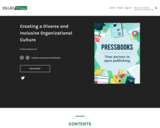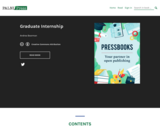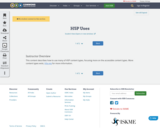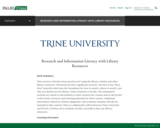
This is to help in the identification of OER materials.
- Subject:
- Education
- Material Type:
- Teaching/Learning Strategy
- Author:
- Andrea Bearman
- Date Added:
- 03/01/2022

This is to help in the identification of OER materials.

Course Description:
In this course, participants will focus on creating engaging materials for their courses. Different forms of engagement will be explored and content created that is relevant to the courses that they teach.
Learning Outcomes:
Create engaging discussion forums. (LO1)
Design new content for current courses. (LO2)
Investigate new forms of media to engage students. (LO3)

A list of possible applied learning opportunities.

Slides are provided that detail our course development process. It's is in a comic-like feel.

Boolean search terms or operators were invented by a mathematician George Boole in 1854. It was quickly forgotten at the time, but it is ideal when applied to searching computerized databases (like a library). Boolean logic uses three operators to demonstrate relationships between terms and definitions. These are AND, OR, NOT. It maybe be helpful to consider the mental model below, to understand how these terms work. This work “Boolean Pizza” by Andrea Bearman is licensed under CC-BY 4.0 International License.

This work, "Connection and Creation" by Andrea Bearman is licensed under CC-BY 4.0 International License.

A quick cartoon about copyright, trademark, and patent.

This resource offers a different perspective on copyright and its relationship with Creative Commons Licenses.

Course Description:
Students in this course will learn organizational best practices to implement diversity, equity, inclusion, and belonging in the workplace. Students will evaluate laws and policies that apply to diversity and inclusion. Students will also build cultural competencies to foster employee recruitment, motivation, satisfaction, and retention. Additionally, students will analyze the leadership skills and processes needed to develop an organizational culture that is diverse and inclusive. Prerequisite: DEI 333
Learning Outcomes:
Analyze organizational best practices on diversity, equity, inclusion, and belonging. (LO1)
Examine the laws and policies that organizations should implement that pertain to diversity, equity, inclusion, and belonging. (LO2)
Determine diversity management techniques needed to attract, engage, and retain employees. (LO3)
Develop leadership skills and cultural competencies to cultivate a diverse and inclusive organizational culture. (LO4)

Learning Objectives1. Share the different types of diversity.2. Recognize potential cultural differences among students.3. Formulate a plan for creating an i...

This video describes equity and how to better serve students in an equitable fashion.

Finally, test yourself with this five minute search activity. Using what you have learned regarding Boolean Operators and some of the other strategies listed, you should be able to successfully find a relevant resource in five minutes or less. Set a timer and see if you can do it.

Learn about the difference between game-based learning and gamification, but also the benefits of games in education.

Course Description: This graduate course is designed to combine classroom theory with practical application through job-related experiences. Students are actively employed in diverse organizations and agencies that relate to their graduate academic training and career objectives. Students will create obtainable SMART goals that apply to their personal and professional goals. Students will build skills related to interviewing etiquette to assist in successful job acquisition. Additionally, students will have the opportunity to reflect on supervisor feedback and their overall experience in the graduate internship.
Learning Outcomes: Upon completion of this course, the student should be able to:
Create achievable SMART goals.
Connect academic knowledge with a professional setting.
Recommend etiquette for professional interviews.
Evaluate personal accomplishments and experiences related to master’s program of study.
Analyze how to achieve professional growth in industry.
Reflect on feedback provided by supervisor.

Course Description:
This graduate course is designed to combine classroom theory with practical application through job-related experiences. Students are actively employed in diverse organizations and agencies that relate to their graduate academic training and career objectives. Students will create obtainable SMART goals that apply to their personal and professional goals. Students will build skills related to interviewing etiquette to assist in successful job acquisition. Additionally, students will have the opportunity to reflect on supervisor feedback and their overall experience in the graduate internship.
Learning Outcomes:
Create achievable SMART goals. (LO1)
Connect academic knowledge with a professional setting. (LO2)
Recommend etiquette for professional interviews. (LO3)
Evaluate personal accomplishments and experiences related to master’s program of study. (LO4)
Analyze how to achieve professional growth in industry. (LO5)
Reflect on feedback provided by supervisor. (LO6)

This content describes how to use many of H5P content types, focusing more on the accessible content types. More content types exist, h5p.org for more information.

How to Build a Virtual Escape Room in Moodle or another platform with H5P.

Easy steps to follow on how to build a scavenger hunt in online learning.

This resource discusses briefly the top forms of family therapy.

This resource will share best practices for using the library website and other library resources. This book has three significant sections. The first is the “Start Here” material which lays the foundation for how to search, where to search, and why you should use the library, where students or faculty. The subsequent sections are meant to aid students in their research for courses and to aid faculty as the locate resources and learning materials for their courses. Additional information related to citation, plagiarism, and academic integrity will also be included in this content. This is a collaborative effort between Trine University and PALNI, to better serve students, faculty, and staff as they use library resources.
Learning Outcomes:
Answer key questions regarding a library search with the library website. (LO1)
Execute better strategies for a successful search using the library website. (LO2)
Locate scholarly resources in the library website. (LO3)
Demonstrate ability to cite sources in APA Style Format. (LO4)
Examine strategies for maintaining academic integrity. (LO5)